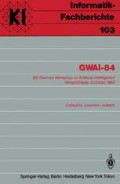Zusammenfassung
Digitale Datenverarbeitungsanlagen können besser sprechen als hören, besser zeichnen als sehen. Das mit ihrer Hilfe realisierbare maschinelle Wahrnehmungsvermögen liegt im Durchschnitt weit unter der Leistungsfähigkeit menschlicher Sinnesorgane. Nichtsdestoweniger gibt es einzelne Spitzenleistungen: Ein Sichtsystem, das gespülte Getränkeflaschen auf noch verbliebene Verunreinigungen hin untersucht, arbeitet zuverlässiger und schneller als ein menschlicher Sichtprüfer und dazu noch ermüdungsfrei. Um diese Fähigkeit zu erreichen, 1st das Sichtsystem weitaus stärker spezialisiert als der menschliche Sehsinn. Um dasselbe System beispielsweise dazu einzusetzen, die Schlagzeilen einer Zeitung zu entziffern, wären aufwendige Umgestaltungen seiner Module notwenig.
Access this chapter
Tax calculation will be finalised at checkout
Purchases are for personal use only
Preview
Unable to display preview. Download preview PDF.
Literaturverzeichnis
D.H. Bollard, C.M. Brown (1982), Computer Vision, Prentice-Hall, Englewood Cliffs, New Jersey
B.C. Bolles, A.B. Coin (1982), Recognising and Locating Partially Visible Objects, Int. J. of Robotics Research 1, No.3, 57–82
M. Brody (1985), Artificial Intelligence and Robotics, Artificial Intelligence 26, in Druck
R.A. Brooks (1981), Symbolic Reasoning Among 3-D Models and 2-D Images, Artificia/Intelligence 17, 285–348
R.A. Brooks (1983), Solving the Findpath Problem by Good Representation of Free Space, IEEE Trans System Man Cybernet. SMC-13, 190–197
L. Broschier, H.-H. Nogel (1982), Volumetric Model and 3-D Trajectory of a Moving Car Derived from Monocular TV Frame Sequences of a Street Scene, Computer Graphics and Image Processing 20, 199–228
J.P. Foith (1979), TV-Sensor for Top-Lighting and Multiple Part Analysis, Proc. 2nd IFAC/IFIP Symposium on Information Control Problems in Manufacturing Technology, Stuttgart
A.B. Hanson, E.M. Bisemon (1978), Visions: A Computer System for Interpreting Scenes, in A.R. Hanson, E.M. Riseman (Hrsg.): Computer Vision Systems, Academic Press, New York, New York
B.K.P. Born (1975), Shape from Shading, in P.H. Winston (Hrsg.): The Psychology of Computer Vision, McGraw-Hill, New York, New York
B.K.P. Born, B.G. Schunck (1980), Determining Optical Flow, AI Memo 572, Artificial Intelligence Lab., MIT, Cambridge
C.L. Jockins, S.L. Tanimoto (1980), Oct-trees and their Use in Representing Three-dimensional Objects, Computer Graphics and Image Processing 14, 249–270
T. Lozono-Péres (1983), Spatial Planning: a Configuration Space Approach, IEEE Trans. Comput C-32, 108–120
H.-H. Nogel, W. Enkelmonn (1985), An Investigation of Smoothing Constraints for the Estimation of Displacement Vector Fields from Image Sequences, IEEE Trans. Pattern Anal. Machine Intell. in Druck
H.-J. Novak (1984), On Verbalizing Real-World Events: An Interface of Natural Language and Vision, in 7th German Workshop on Artificial Intelligence, Dassel/Solling, B. Neumann (Hrsg.), Informatik Fachberichte 76, Springer-Verlag Berlin Heidelberg New York Tokyo, pp. 100–107
B. Radig (1979), Auswertung digitisierter Fernsehbilder zur Beschreibung bewegter Objekte, Bericht IFI-HH-B-59/79 des Fachbereichs Informatik der Universität Hamburg
B. Radig (1981), Image Region Extraction of Moving Objects, in T.S. Huang (Hrsg.): Image Sequence Analysis, Springer-Verlag Berlin Heidelberg New York, pp. 311–354
B. Radig (1982), Symbolische Beschreibung von Bildfolgen I: Relationengebilde und Morphismen, Bericht IFI-HH-B-90/82 des Fachbereichs Informatik der Universität Hamburg
B. Radig (1983), 2D und 3D Objektbeschreibung für Sichtsysteme, Proc. 5. DAGM-Symposium Karlsruhe, H. Kazmierczak (Hrsg.), VDE-Fachberichte 35, VDE-Verlag Berlin — Offenbach, pp. 300–318
B. Radig (1984), Image Sequence Analysis Using Relational Structures, Pattern Recognition 17, 161 – 167
R. Rasenfeld (1984), Image Analysis: Problems, Progress and Prospects, Pattern Recognition 17, 3–12
H. Samet (1988), Region Representation: Quadtrees from Boundary Codes, Comm. ACM 23, 163–17
R.C. Schank, R.P. Abelson (1977), Scripts, Plans, Goals and Understanding, Erlbaum, Hillsdale, New Jersey
K.A. Stevens (1979), Representing and Analyzing Surface Orientation, in P.H. Winston, R.H. Brown (Hrsg.): Artificial Intelligence: An MIT Perspective, Band 2, MIT Press, Cambridge, Massachusetts
S. Tanimoto, T. Pavlidis (1975), A Hierarchical Data Structure for Picture Processing, Computer Graphics and Image Processing 4, 104–119
H. Tropf, I. Walter, H.-P. Kammerer (1984), Erweiterte Übergangsnetze (Augmented Transition Networks) als prozedurale Modelle im Bereich der Bildanalyse, in Mustererkennung 84, Proc. DAGM/ÖAGM Symposium, Graz, W. Kropatsch (Hrsg.), Informatik Fachberichte 87, Springer-Verlag Berlin Heidelberg New York Tokyo, pp. 290–296
H. Westphal (1984), Dreidimensionale Modellierung bewegter Objekte unter Ausnutzung von Helligkeitsveränderungen zur Formbestimmung, Dissertation am Fachbereich Informatik der Universität Hamburg
R.J. Woodham (1978), Photometric Stereo: A Reflectance Map Technique for Determining Surface Orientation from Image Intensity, Proc. 22nd Intern. SPIE Symposium., San Diego, California, pp. 136–143
Author information
Authors and Affiliations
Editor information
Editors and Affiliations
Rights and permissions
Copyright information
© 1985 Springer-Verlag Berlin Heidelberg
About this paper
Cite this paper
Radig, B. (1985). Bildverstehen und Künstliche Intelligenz. In: Laubsch, J. (eds) GWAI-84. Informatik Fachberichte, vol 103. Springer, Berlin, Heidelberg. https://doi.org/10.1007/978-3-642-46546-8_8
Download citation
DOI: https://doi.org/10.1007/978-3-642-46546-8_8
Publisher Name: Springer, Berlin, Heidelberg
Print ISBN: 978-3-540-15669-7
Online ISBN: 978-3-642-46546-8
eBook Packages: Springer Book Archive

